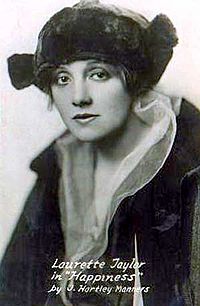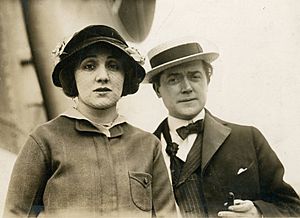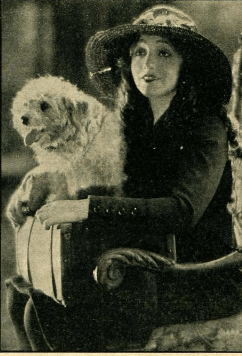Laurette Taylor facts for kids
Laurette Taylor (born Loretta Helen Cooney; April 1, 1883 – December 7, 1946) was a famous American actress. She starred on stage and in silent films. Laurette is best known for playing Amanda Wingfield. This was in the very first show of Tennessee Williams's play, The Glass Menagerie.
Contents
About Laurette Taylor's Life
Laurette Taylor was born Loretta Helen Cooney. She was born in New York City on April 1, 1883. Her parents were James and Elizabeth Cooney. She also had a younger sister named Elizabeth.
Her Marriages and Family
At 18, Laurette married her first husband, Charles Alonzo Taylor. They got married on May 1, 1901. Charles was much older than Laurette. They had two children together: Dwight Oliver Taylor and Marguerite Courtney. They later divorced around 1910.
On December 22, 1912, Laurette married J. Hartley Manners. He was a playwright from Britain. Manners wrote the play Peg o' My Heart. This play was a huge success for Laurette. She toured with it all over the country.
The play's success led to a movie version in 1922. Laurette starred in the film, and King Vidor directed it. A copy of the movie is still kept at the Library of Congress. Laurette and Manners stayed married until he passed away in 1928.
Laurette Taylor's Stage Career
Laurette Taylor first appeared on Broadway in 1908. The play was called The Great John Ganton. She also acted in other plays like The Ringmaster and Alias Jimmy Valentine. Some of her other roles were in Seven Sisters and The Bird of Paradise.
She even performed in a special show called Laurette Taylor in Scenes From Shakespeare. In this show, she acted out parts from famous plays. These included Romeo and Juliet, The Merchant of Venice, and The Taming of the Shrew.
Becoming a Star Actress
According to theatre critic Brooks Atkinson, Laurette became a star in 1910. This happened after her role in The Girl in Waiting. Her acting seemed so natural and real. People sometimes wondered if she was truly acting. She didn't use the usual dramatic styles of her time.
In 1945, Variety magazine held a poll. Laurette Taylor was voted the best actress.
Her Biggest Stage Hit
Her most famous play was Peg o' My Heart. Her husband, Manners, wrote it just for her. It was a simple story about a Cinderella-like character. The play ran on Broadway from December 1912 to May 1914. It had 607 performances, which was a record for a play.
This play made Laurette and her husband a lot of money. It also made her "the most generally worshiped star of her time." This role proved she was a very skilled actress. After Broadway, Laurette performed Peg o' My Heart in London. The show closed in 1915 due to German bombings.
In 1917, she starred in Out There. This was another play written by Manners. She played a young Cockney girl. This girl became a Red Cross nurse through her patriotism. She helped wounded soldiers and cheered them up. A line from the play, "If I go, will you go?", became a famous poster for recruiting soldiers.
In 1918, Laurette starred in Happiness. This was another successful play by Manners. She later played the same role in the 1924 movie. The play was a sweet comedy. It was about a girl from Brooklyn who taught a rich customer about happiness.
Laurette later toured the country with Peg o' My Heart again. It reopened on Broadway in 1921. It ran for another 692 performances.
Changes in Public Taste
By the 1920s, people's tastes in theatre changed. Laurette had always starred in simple plays. These plays were popular before World War I. But now, her popularity began to fade. Theatre critic John Corbin said she had great talent. However, her old-fashioned plays held her back.
Manners tried to write a more serious play for her. It was called The National Anthem. This play was about "high motives" and criticized the "jazz generation." It opened in 1922 but was not successful. This was the last time Laurette appeared in a play written by her husband.
Laurette Taylor's Movies
Laurette Taylor wanted to make her first film in Peg o' My Heart. Many actresses wanted this role. Even Mary Pickford offered a very large sum for the movie rights. The play was already very popular. Any actress in the role would likely be a success.
But Laurette held onto the movie rights for herself. It took years for the film to be made. The movie version was much bigger than the play. When it was released, it was an instant hit with audiences. Laurette then made another movie based on her stage success, Happiness. Her third and final film for MGM was One Night in Rome.
She never made another movie after that. David O. Selznick asked her to do a screen test in 1938. This was for a role in his film The Young in Heart. Laurette did the test, but she turned down the part. The actress Minnie Dupree was cast instead. This screen test still exists and has been shown on TV.
In the documentary Broadway: The Golden Age, many actors were asked who influenced them. Laurette Taylor's name was mentioned again and again. The documentary even has a section about her 1938 screen test.
How Laurette Taylor Acted
Laurette Taylor wrote an essay about acting. It was called "The Quality Most Needed." This essay was in some early versions of the book Actors on Acting. In it, Laurette wrote about how important imagination is for an actress. She believed it was more important than physical beauty. She felt imagination helped an actress truly create art.
She didn't like performances where you could "see the acting." She also warned against following old acting traditions too much. She said it "cramps creative instinct." Laurette believed an imaginative actress would make you feel you could picture her character. This would be true even outside the play's story. Laurette praised actresses who used their "heart and soul and brain" to build a character. They did this not for the audience, but for themselves.
Laurette Taylor's Legacy
After Laurette's death, Tennessee Williams praised her. He spoke of "the great warmth of her heart." He said her art had a special glow. He compared it to beautiful poetry. It gave him a feeling of sudden understanding.
In 1960, a play about Laurette called Laurette was planned. Judy Holliday was to star, and José Quintero directed. But it closed early because Judy Holliday was sick. For many years, film director George Cukor tried to make a movie about Laurette's life. He was not successful.
In 1963, a musical about Laurette opened on Broadway. It was called Jennie. Mary Martin played the main role. The musical ran for only 82 performances. It received mixed reviews. A short play called Opening Night also appeared off-Broadway in 1963. Peggy Wood played Fanny Ellis, a famous old star. Many people thought Fanny was based on Laurette Taylor.
In the 2004 documentary Broadway: The Golden Age, by the Legends Who Were There, many Broadway actors spoke about Laurette. They said her performances in Glass Menagerie and Outward Bound were unforgettable. The documentary includes a rare clip of Laurette's screen test. This test was for David O. Selznick's studio. Studio executives reportedly did not approve of it.
Her Personal Papers
Laurette's daughter, Marguerite Courtney, said Laurette destroyed many things. After her husband Manners died in 1928, she got rid of press books, letters, and photos. She also destroyed other items from their life together.
In 1995 and 2009, her family gave her remaining papers to the Harry Ransom Center. This collection includes letters, photos, and sound recordings. It also has reviews, articles, and legal papers. The Ransom Center also has Laurette's screen test for David O. Selznick. There are also many items related to Tennessee Williams.
Famous Fans of Laurette Taylor
- Actress and teacher Uta Hagen wrote about Laurette Taylor. In her 1991 acting book, A Challenge for the Actor, she called Laurette her "idol." She saw Laurette as a great example of an actor. Laurette said she truly understood a character when she was "wearing the underpants of the character." Hagen praised Laurette's acting. She said Laurette's actions and words always felt new and real.
- Actor Charles Durning once saw Laurette act. He said, "I thought they pulled her off the street. She was... so natural."
- Actor Martin Landau said Laurette "was almost like this woman had found her way into the theatre, through the stage door, and was sort of wandering around the kitchen."
- Actress Peg Entwistle was a fan of Laurette from age 13. She saw Laurette in Peg O' My Heart in 1921. Laurette's performance inspired Peg so much. She changed her name from Millicent to "Peg." Years later, in 1932, Peg acted with Laurette on Broadway in J. M. Barrie's comedy Alice Sit-by-the-Fire.
Images for kids
See also
 In Spanish: Laurette Taylor para niños
In Spanish: Laurette Taylor para niños







